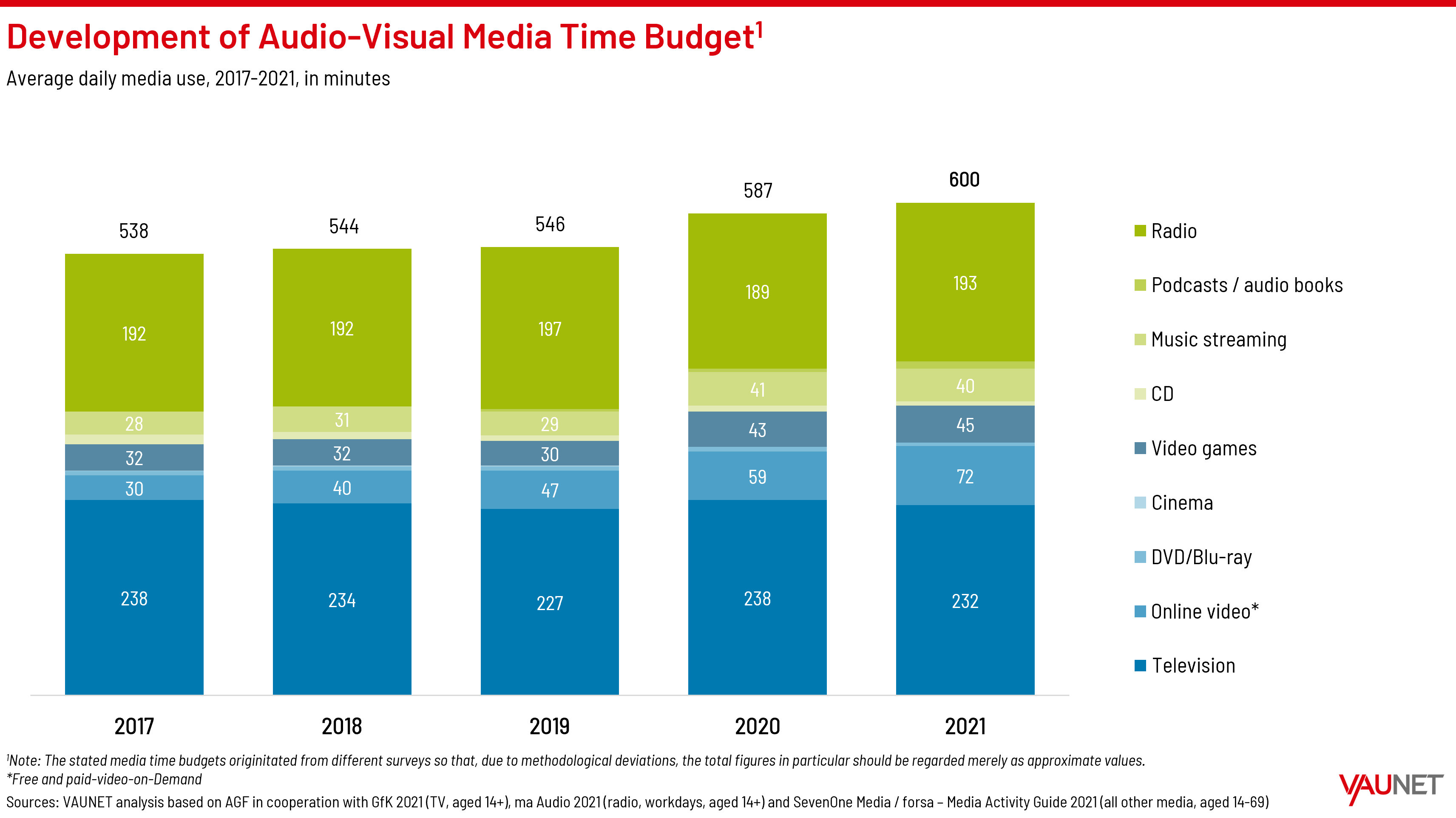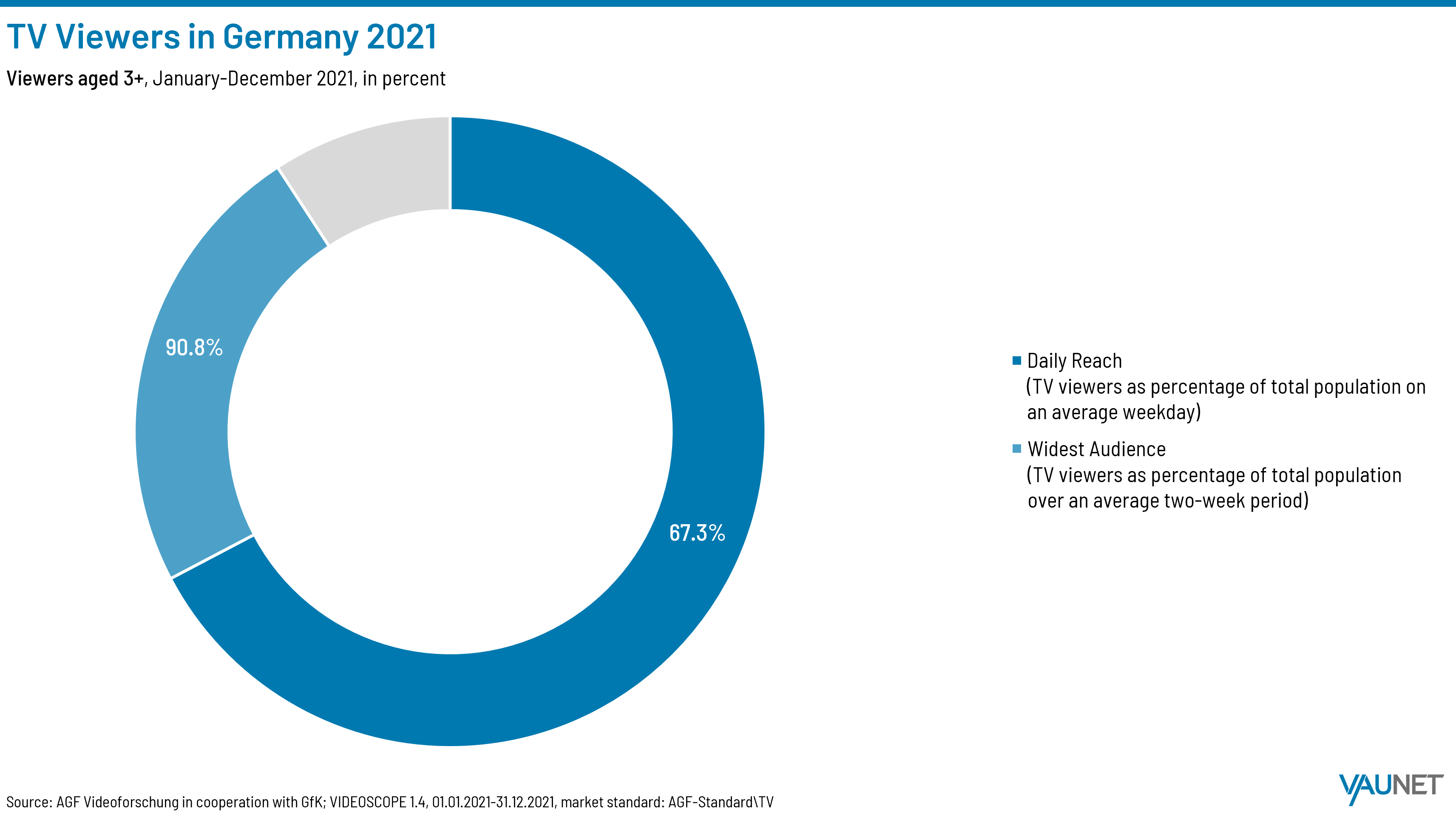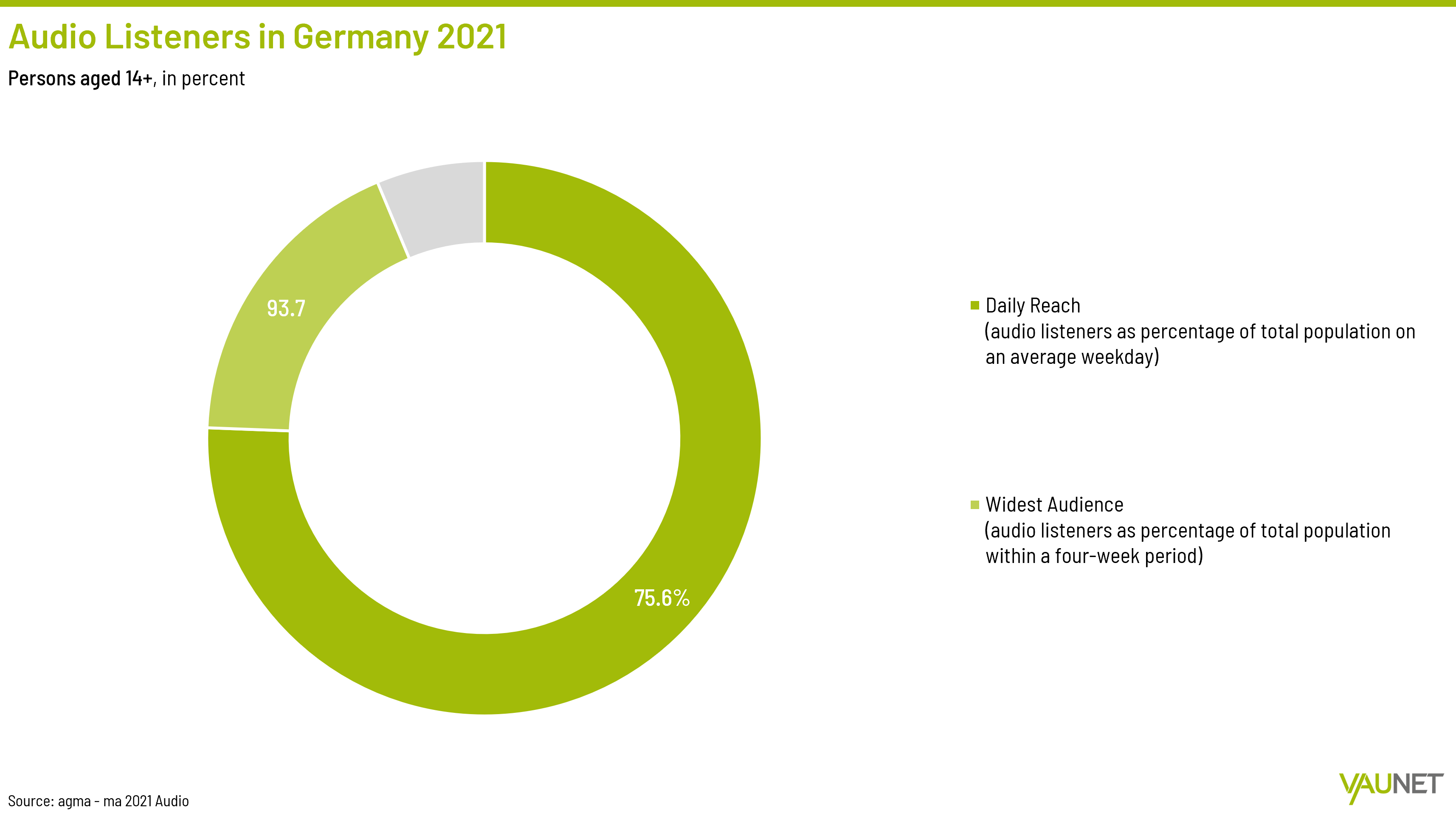Berlin, 3 February 2022 - The use of audio and audiovisual media in Germany increased in 2021 for the second year running since the start of the Covid-19 pandemic, reaching a new record. For the first time, people aged 14 and over in Germany consumed audiovisual media for an average of 10 hours per day.
Daily use of television, radio and other audiovisual media grew over the previous year by 13 minutes to 10 hours (2020: 9 hours and 47 minutes) – 54 minutes longer than pre-pandemic use in 2019 (9 hours and 6 minutes). These were the key findings of the VAUNET Media Usage Analysis for 2021, compiled by the VAUNET Association of Private Media on the basis of secondary sources and published today.

Johannes Leibiger, Head of Media Economics & Research at VAUNET: “In 2020, audiovisual media consumption rose sharply, especially during the Covid peaks and lockdowns. This increased usage compared to 2019, the final year before the pandemic, wasn’t just maintained in 2021, but actually rose again. The biggest gains in 2021 were recorded for online video, radio and video games. Overall, radio and TV remain by far the most popular types of media.”
Frank Giersberg, Managing Dirctor of VAUNET: “The increase in use of almost an hour a day during the pandemic years reflects the high need for reliable information and entertainment. It underlines the extremely high relevance of audio and audiovisual media for society at large. At the same time, commercial media companies have suffered major economic challenges during the Covid pandemic. Safeguarding their finances and hence preserving diversity in the media will therefore be a crucial task for media policy over the next few years.”

Daily video consumption among Germans aged 14 and over totalled 5 hours and 53 minutes in 2021, another new record. Increasing by 7 minutes on the previous year (2020: 5 hours and 46 minutes), the amount of time spent watching video rose by 43 minutes compared to 2019. In a direct year-on-year comparison, although daily TV viewing declined slightly to 3 hours and 52 minutes (2020: 3 hours and 58 minutes), it remained above pre-crisis levels (2019: 3 hours and 47 minutes).1 The popularity of online video continued to rise, with 72 minutes a day being watched by people aged 14 to 69 (2020: 59 minutes). Compared to pre-pandemic levels, the consumption of free online videos and paid video-on-demand content increased by 25 minutes (2019: 47 minutes).2
Average daily audio usage in 2021 was estimated to be 4 hours and 7 minutes (2020: 4 hours and 1 minute). Compared to the final pre-pandemic year (2019: 3 hours and 56 minutes), the consumption of audio content was up by 11 minutes. Weekday radio listening continued to account for the lion’s share last year among listeners aged 14+ at 3 hours and 13 minutes (2020: 3 hours and 9 minutes; 2019: 3 hours and 17 minutes).3
Internet media offerings were used for an average of 2 hours and 29 minutes in 2021 (2020: 2 hours and 13 minutes). Compared to 2019, online media use among 14- to 69-year-olds increased by 48 minutes (2019: 1 hour and 41 minutes). Of this, 116 minutes (previous year: 104 minutes; 2019: 79 minutes) were spent on online video, music streaming/MP3s and podcasts. Other forms of audiovisual media use among 14- to 69-year-olds in Germany such as CDs, DVDs/Blu-ray, audiobooks, cinema and video games totalled 59 minutes (2020: 56 minutes; 2019: 43 minutes).2
During the course of the day last year, on average radio was the most frequently used medium from morning until afternoon. The internet took over between about 2 and 6pm, while in the evening, television was the most popular medium with the highest reach.4

In 2021, 90.8 per cent of the total population aged 3 and over in Germany watched television regularly (2020: 92.0%; 2019: 91.5%),1 93.7 per cent of adults aged 14 and over listened regularly to audio and radio (2020: 93.6%; 2019: 93.8%),3 while 84.7 per cent of people aged 16 and over made repeated use of the internet between January and October (October to November 2020: 82.5%; 2019: 82.7%).5 The daily reach figures were 67.3 per cent for television (2020: 69.3%; 2019: 67.2%), 75.6 per cent for audio (2020: 75.5%; 2019: 77.1%), and 58.8 per cent for the internet (2020: 57.0%; 2019: 47.0%).


Total daily media usage in Germany across all media genres was 11 hours and 18 minutes in 2021 (2020: 11 hours and 6 minutes). Compared to the pre-pandemic level in 2019, daily media use thus rose by a total of 62 minutes, an increase of more than an hour (2019: 10 hours and 16 minutes).
1AGF Video Research Working Group in cooperation with GfK; 2SevenOne Media/forsa – Media Activity Guide 2021; 3agma Media Analysis Working Group – ma 2021 Audio; 4VuMA Touchpoints 2022; 5agof Online Research Working Group, daily digital facts, January–October 2021, unique users in per cent, people aged 16+.
Download VAUNET’s Media Usage Analysis 2021:
Study „VAUNET-Mediennutzungsanalyse: Mediennutzung in Deuschland 2021 “
Methodology:
VAUNET’s Media Usage Analysis is based on the ongoing evaluation of third-party sources, including data provided by agma Media Analysis Working Group, VuMA Consumption and Media Analysis, Video Research Working Group, agof Online Research Working Group, and the MAG Media Activity Guide published by SevenOne Media and forsa. Since cross-media information on the duration of daily media usage is gathered from a variety of sources, in particular the total figures should merely be regarded as approximate values owing to methodological differences. The comparative data relating to daily media consumption in the various categories is gleaned from figures provided by agma regarding radio usage (listeners aged 14 and over), AGF Video Research Working Group for TV usage (viewers aged 14 and over), and MAG published by SevenOne Media and forsa concerning the consumption of other media (users aged between 14 and 69). Data relating to the total reach of television and radio is based on the widest audiences and relates to periods of two weeks for TV and four weeks for radio.
Other VAUNET publications:
VAUNET keeps track of market developments in Germany’s audio and audiovisual media sector with regular surveys and publications. In May 2022, VAUNET will publish its annual spring forecast for the advertising market based on the advertising statistics for 2021. Its pay TV statistics outlining developments on the pay TV market will be published in July 2022, to be followed in October 2022 by its revenue forecast for audio and audiovisual media.



